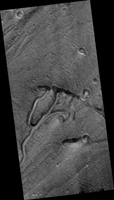
Map Projected Browse Image
Click on image for larger versionThis image focuses on small channels formed on the floor of the much larger Kasei Valles, one of the largest outflow channels on Mars.
The enormous floods that formed such channels sometimes flowed around either side of topographic rises forming islands with a streamlined shape. The channels in this image are located on the trailing edge of such a formation (white shaded box). The small channels formed linear coalescing pits, perhaps by ground ice sublimating into the atmosphere leaving the surface material to collapse. Much of the remaining material seems to be made up of easily eroded sediments likely deposited by the floodwaters, which have subsequently formed dunes inside the channels.
Kasei extends almost 1600 kilometers (980 miles) across the surface towards the northeast before it empties into Chryse Planitia in the northern lowlands of Mars.
The map is projected here at a scale of 25 centimeters (9.8 inches) per pixel. (The original image scale is 29.2 centimeters [11.5 inches] per pixel [with 1 x 1 binning]; objects on the order of 88 centimeters [34.6 inches] across are resolved.) North is up.
The University of Arizona, in Tucson, operates HiRISE, which was built by Ball Aerospace & Technologies Corp., in Boulder, Colorado. NASA's Jet Propulsion Laboratory, a division of Caltech in Pasadena, California, manages the Mars Reconnaissance Orbiter Project for NASA's Science Mission Directorate, Washington.

